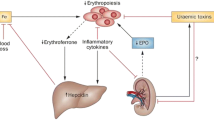Abstract
Calcium oxalate (CaOx), calcium phosphate (CaP), and uric acid or urate are the most common crystals seen in the kidneys. Most of the crystals evoke an inflammatory response leading to fibrosis, loss of nephrons, and eventually to chronic renal failure. Of the three, CaOx monohydrate is the most reactive, whereas some forms of CaP do not evoke any discernible response. Reactive oxygen species are produced during the interactions between the crystals and renal cells and are responsible for the various cellular responses. CaOx crystals generally form in the renal tubules. Exposure of renal epithelial cells to CaOx crystals results in the increased synthesis of osteopontin, bikunin, heparan sulfate, monocyte chemoattractant protein 1 (MCP-1), and prostaglandin (PG) E2, which are known to participate in inflammatory processes and in extracellular matrix production. CaOx crystal deposition in rat kidneys also activates the renin–angiotensin system. Both Ox and CaOx crystals selectively activate p38 mitogen-activated protein kinase (MAPK) in exposed tubular cells. CaP crystals can form in the tubular lumen, tubular cells, or tubular basement membrane. Renal epithelial cells exposed to brushite crystals produce MCP-1. Basic CaP and calcium pyrophosphate dihydrate induce mitogenesis in fibroblasts, stimulate production of PGE2, and up-regulate the synthesis of metalloproteinases (MMP) while down-regulating the production of inhibitors of MMPs through activation of p42/44 MAPK. Deposition of urate crystals in the kidneys becomes associated with renal tubular atrophy, interstitial fibrosis, and development of inflammatory infiltrate. Renal epithelial cells exposed to uric acid crystals synthesize MCP-1 as well as PGE2. Monocytes or neutrophils exposed to urate crystals produce tumor necrosis factor α, interleukin-1 (IL-1), IL-6, and IL-8. Expression of IL-8 is mediated through extracellular signal-regulated kinase 1 (ERK-1)/ERK-2 and nuclear transcription factors activated protein 1 and nuclear factor κβ. Urate crystals also stimulate the macrophages to produce MMPs.
Similar content being viewed by others
Author information
Authors and Affiliations
Corresponding author
About this article
Cite this article
Khan, S. Crystal-induced inflammation of the kidneys: results from human studies, animal models, and tissue-culture studies. Clin Exp Nephrol 8, 75–88 (2004). https://doi.org/10.1007/s10157-004-0292-0
Received:
Accepted:
Issue Date:
DOI: https://doi.org/10.1007/s10157-004-0292-0




